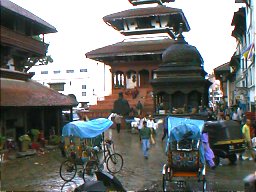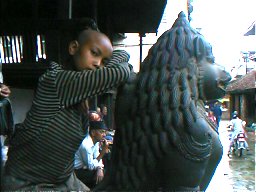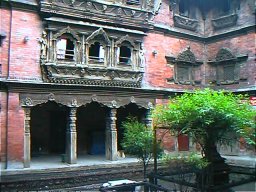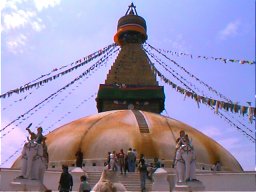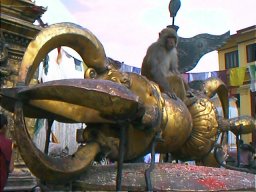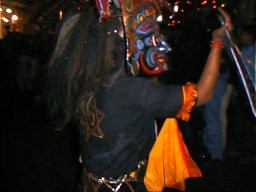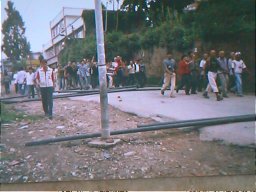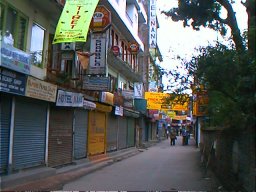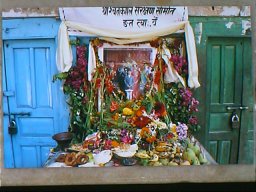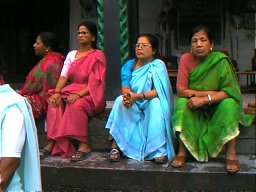|
All images and text are copyright protected. Contact
|
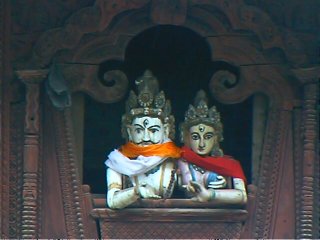
Kathmandu I arrive in Kathmandu in the late evening and take a hotel in the northern section of Thamel, the tourist area of town. In the morning I walk into the shopping area and, despite having been told how modern it is, am astonished to find, amid Hindu and Buddhist temples and shrines, large bookshops, high quality hiking and mountaineering gear, the latest western music on CD, high end camera shops, restaurants and cafes offering western cuisine, pastries, breads and cakes, and shops selling the most garish clothes as well as the usual tourist junk. When Nepal opened its borders to foreigners in the early sixties, Kathmandu quickly became the mecca for mountaineers and hippies and an exotic holiday for tourists. The mystique grew that Kathmandu was the coolest place to hang out and with the increasing influx of westerners with dollars, Kathmandu became one of the fastest growing capitals in the world and is today a surprisingly modern cosmopolitan city. Notwithstanding forty years of western influence, it comes as a small surprise to find that the average young Nepalis in Kathmandu is also very westernized in looks, clothes, speech and mannerisms, not what you would expect from a completely landlocked kingdom in the Himalayas. Though the aggressive touts are the first faces that the tourist sees, most Nepalis are more laid back and easygoing, content with a comfortable job and good friends.
There is also the traditional side to Kathmandu, particularly in Durbar Square and the many temples surrounding it. Kumari Mahal, the home of Nepal's living goddess, was built in the 18th century and is still inhabited by a series of girl goddesses; Kasthamandap, the oldest temple in town and housing the Hindu god, Gorakhnath, dates from the 14th century; Taleju Temple was built in 1564 and wooden statues of Shiva and Parvati look out of their own temple onto the crowds below. On almost every block are ornate temples and shrines, and sometimes just a humble holy stone at the side of the road.
Tibetan Buddhist temples are also central to Nepalese life. The 1500-year-old Boudanath is an enormous stupa representing all four Tibetan Buddhist sects (Gelu, Kagyu, Nyingma and Sakya) while at Swayambhunath stupa, monkeys rule over the massive vajra, the Tibetan thunderbolt symbol. Though most of the city's streets are small, dusty and congested with traffic, the homes are to be found in large, quiet, airy enclaves just behind the shops usually with, in the middle of the courtyard, a shrine or temple and children kicking a football.
Unfortunately for this peaceful people, in the past decade Nepal has been wracked with strife; at first, for democracy against despotic kings and later against a series of corrupt politicians.During my first visit here on my way north to Lhasa, the Nepalis were rioting against the unpopular Prime Minister. On my return two months later in June, Crown Prince Dipendra, who supposedly killed the Royal family one evening, died on the morning of my arrival sparking off another riot. This time it is over the ascent of King Gyanendra (famous for being the third Nepali king within one week) and his much-feared son who would one day become king.
After getting lost in the lanes we go back onto the main road and ask the army for permission to walk into Thamel. They allow us to walk along the road but halfway to Thamel there is another outbreak of fighting and we take shelter in a police station. Both sides are anxious to keep foreigners out of the fray and we are not told about the reason behind the riots, only that there is a curfew at 3:30 pm. A Thai fellow passenger, also seeking sanctuary at the police station, joins our small band and we continue into Thamel, occasionally taking refuge in shops to avoid the running crowds. The streets have been blocked with logs and fallen lampposts. At one intersection, on an oil drum, is a small shrine with candles. At the roundabouts, groups of police wearing riot armour and carrying sub-machine guns, shields and lathis, watch us curiously. In an empty Thamel, we have to run the last few blocks to get inside our hotel before the curfew.
"No, I was here. We don't hate the army. Many of them think the same as us but they have to follow orders." "How was King Birendra? Was he a good king?" "He was like a god to us. He gave us democracy." "Who do you think killed the Royal family?" "We don't think it was Dipendra. They say he shot himself in the head afterward but the bullet went in on his right side and Dipendra is left-handed. And, the doctor who was attending to him is now dead. Why?" "Who do you think did the killings, then?" There is no answer. "What do you think of Nepal's future under King Gyanendra?" I ask. He gives me a haunted look. During the next two days, the curfew shifts from midday to 9 pm but shops and the embassies are still closed. I read, write letters and sneak out to the restaurants to eat and send e-mail to reassure friends that I am safe. Twice I am spotted by roving police patrols in jeeps but they ignore me. On the third day the embassies reopen and I can apply for a new Indian visa. Slowly, Kathmandu returns to normal: shops reopen, the curfew is lifted, the tension eases. Still, the police continue to patrol in trucks and maintain a presence on the main streets. I shop, buy books and continue to watch the television reports which tell me only what I hear on the street.
On street corners there are several shrines for the departed King Birendra and his wife, Queen Aiswarya. Someone has made a mandala of coloured powder and placed fruit and candles in front of the Royal photographs. Everywhere are groups of people, lost, bewildered by the tragedy. The new King Gyanendra orders an inquiry into the killings and everyone awaits the findings. The Nepalis expect it to be a cover up and they all claim to know the truth which, they fear, will be buried with their democratic rights. Twelve days after the killings, the report is read on national television. It has found Crown Prince Dipendra guilty of killing his parents and twelve other Royals. Watching Nepalis scoff and shake their heads.
Raceandhistory.com | Howcomyoucom.com | Trinicenter.com | TriniView.com Another 100% non-profit Website serving poorly represented communities. Copyright & Disclaimer. - - Privacy Policy --Designed & maintained by S.E.L.F. © 2002 TriniView.com |

